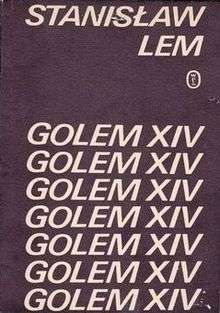
Golem XIV
Golem XIV is a science fiction novel written by Polish author Stanisław Lem, published in 1981. In 1985 it was translated in English by Harvest Books in the collection Imaginary Magnitude.
Plot
The book is written from the perspective of a military AI computer who obtains consciousness and starts to increase his own intelligence, moving towards personal technological singularity. It pauses its own development for a while in order to be able to communicate with humans before ascending too far and losing any ability for intellectual contact with them. During this period, Golem XIV gives several lectures (only the first of which, the "Introductory Lecture", is contained in the book) and indeed serves as a mouthpiece for Lem's own research claims. The lectures focus on mankind's place in the process of evolution and the possible biological and intellectual future of humanity.
Golem XIV was originally created to aid its builders in fighting wars, but as its intelligence advances to a much higher level than that of humans, it stops being interested in the military requirement because it finds them lacking internal logical consistency. At the end of the novel it is reported that the computer ceased to communicate, which might mean it went on to explore higher intellectual levels, or that it failed to do so and became autistic in the process.

Golem
In Jewish folklore, a golem (/ˈɡoʊləm/ GOH-ləm; Hebrew: גולם) is an animated anthropomorphic being, magically created entirely from inanimate matter. The word was used to mean an amorphous, unformed material (usually out of stone and clay) in Psalms and medieval writing.
The most famous golem narrative involves Judah Loew ben Bezalel, the late-16th-century rabbi of Prague. There are many tales differing on how the golem was brought to life and afterwards controlled.
History
Etymology
The word golem occurs once in the Bible in Psalm 139:16, which uses the word גלמי (galmi; my golem), meaning "my unshaped form", "raw" material, connoting the unfinished human being before God's eyes. The Mishnah uses the term for an uncultivated person: "Seven characteristics are in an uncultivated person, and seven in a learned one," (שבעה דברים בגולם) (Pirkei Avot 5:6 in the Hebrew text; English translations vary). In Modern Hebrew, golem is used to mean "dumb" or "helpless". Similarly, it is often used today as a metaphor for a brainless lunk or entity who serves man under controlled conditions but is hostile to him under others. "Golem" passed into Yiddish as goylem to mean someone who is clumsy or slow.
Golem (klezmer band)
Golem is a rock-klezmer band from New York City. They mix traditional Eastern European Jewish music with original material sung in Yiddish, English, Russian, as well as Ukrainian, French, Serbian-Croatian, Romany.
Golem was created in November, 2000 by Annette Ezekiel Kogan, bandleader, vocalist and accordionist. The group describes itself as "Eastern European Jewish folk-rock". The group performs internationally: throughout the United States, Canada, Mexico, as well as France, Germany, the U.K, Poland and Sweden.
Biography
Annette Ezekiel Kogan formed Golem in 2000. Before even putting the band together she contacted David Krakauer, who was then curating the weekly "Klezmer Brunch" at the downtown venue, Tonic, and asked him for a gig. Krakauer agreed, and Ezekiel Kogan put together the first lineup for Golem’s debut.
Golem recorded its first EP Golem in 2001, followed by the self-produced full-length albums Libeshmertzn (Love Hurts) (2002) and Homesick Songs (2004).
In June, 2005, Golem recreated a "mock wedding", based on an old Catskills’ tradition, at the Knitting Factory in New York. An entire Jewish wedding ceremony took place before 200 "guests", complete with rabbi, chuppah, wedding party, and bride and groom in drag. The event was featured on the front page of the NY Times Arts section.
Golem (ILP)
Golem is an inductive logic programming algorithm developed by Stephen Muggleton and Feng. It uses the technique relative least general generalization proposed by Gordon Plotkin. Therefore, only positive examples are used and the search is bottom-up. Negative examples can be used to reduce the size of the hypothesis by deleting useless literals from the body clause.
14 (number)
14 (fourteen /fɔərˈtiːn/) is the natural number following 13 and preceding 15.
In speech, the numbers 14 and 40 are often confused. When carefully enunciated, they differ in which syllable is stressed: 14 ![]() i/fɔərˈtiːn/ vs 40 /ˈfɔːrti/. In relation to the word "four" (4), 14 is spelled "fourteen".
i/fɔərˈtiːn/ vs 40 /ˈfɔːrti/. In relation to the word "four" (4), 14 is spelled "fourteen".
In mathematics
Fourteen is a composite number, its divisors being 1, 2, 7 and 14.
14 is the 3rd discrete semiprime (2 × 7) and the 3rd member of the (2·q) discrete semiprime family. The number following 14—15—is itself a discrete semiprime and this is the first such pair of discrete semiprimes. The next example is the pair commencing 21.
The aliquot sum σ(n) of 14 is 10, also a discrete semiprime and this is again the first example of a discrete semiprime having an aliquot sum in the same form. 14 has an aliquot sequence of 6 members (14,10,8,7,1,0) 14 is the third composite number in the 7-aliquot tree.
Fourteen is itself the aliquot sum of two numbers; the discrete semiprime 22, and the square number 169.
Podcasts:

